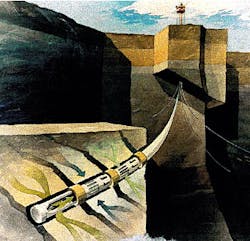Intelligent completions allow control of flow (shown as arrows) as well as the monitoring of downhole conditions (Fig. 1).A new center for testing innovative downhole equipment has been established at the Rogaland Research Institute at Stavanger.
Saga Petroleum ASA was instrumental in creating the center, and according to Saga, the facility is the only one of its kind in the world.
Main aim
The center aims to enhance the quality and operation of sophisticated well completion equipment. It will emphasize the testing, under simulated well conditions, of intelligent completion equipment (Fig. 1). Saga calls this equipment a downhole instrumentation and control system (Diacs).The technology includes sliding sleeves for controlling the well stream so that oil recovery is improved while produced water is reduced.
Saga plans Diacs installations for several wells producing to the Snorre tension leg platform and the Snorre B production floater.
The Rogaland facility allows the equipment to be tested under high pressure and temperature with advanced measuring equipment. These tests will significantly improve the knowledge of the durability and operational safety of this equipment in offshore applications, Saga notes.
Diacs
Diacs allows downhole valves to be remotely controlled from the surface by electronics, hydraulics, or a combination of the two and can improve hydrocarbon recovery without time-consuming well interventions.Also, Saga expects that Diacs will reduce the cost for monitoring the reservoir while simultaneously gathering data from the producing well. Integrated sensors within the valves monitor such downhole information as pressure and temperature.
Reduced produced water is another aim of the equipment. Less water will cut treating chemical costs as well as lessen discharges to the sea, which can cause environmental problems.
Saga says the experience with installed systems so far indicates that currently available systems have an unsatisfactory reliability and useful life. It is testing Diacs on land to increase the reliability and instrument life, but expects the new facility will subject equipment to more-realistic well conditions so that weaknesses can be identified and the equipment modified prior to field installation.
The facility is part of the Rogaland Ullrigg drilling and well center (UBBS).
Copyright 1999 Oil & Gas Journal. All Rights Reserved.


